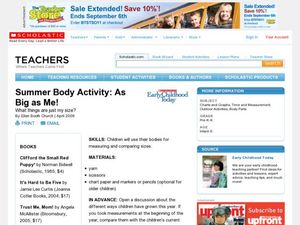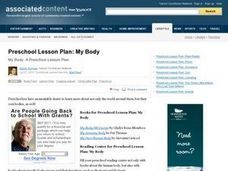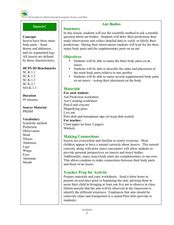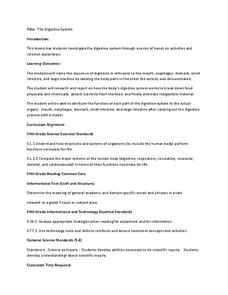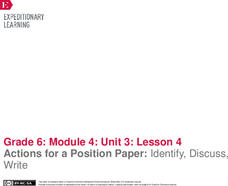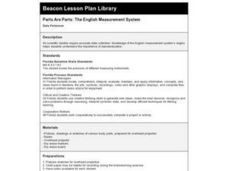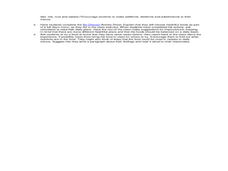Curated OER
Summer Body Activity: As Big as Me!
Students explore things that are their size, literally. In this early childhood lesson plan, students use their bodies for measuring and comparing sizes as they work in pairs to complete the activity.
Curated OER
Understanding the Body, Day 1: Anatomy
Intended for moderate to severely disabled students, this lesson focuses on building an understanding of human anatomy. A secondary special education class reviews, identifies, and labels parts of the body. Including the internal and...
Curated OER
Body Parts in Spanish
Students use Spanish to recognize and recall body parts. In this Spanish anatomy lesson, students identify and name the parts of the body in Spanish. Students describe a person physically by his hair and color of eyes. Students graph...
Curated OER
"My Body"
Students participate in various shared reading and writing activities related to the book "My Body" by Rhonda Jenkins. They identify and list words that could be used to label other body parts in the book, draw a picture of their face...
Curated OER
Summer Body Activity: A Nose Workout
Students have sensory experiences with the sweet smell of discovery. In this early childhood science lesson, students use their sense of smell as they create and compare their very own fragrance essences with a variety of provided...
Curated OER
Body Buddies
First graders study body parts and make life-size outline of their bodies. They label the outline with twenty body parts.
Curated OER
Ant Bodies
Learners name the three parts that comprise an insect body. In this ant instructional activity, students make connections regarding the curiosity of insects as it touches upon the learners' personal perspectives. Students then...
Curated OER
Learning About Animals' Bodies
Students research different animals (mammals, reptiles, amphibians, insects, birds, fish) and create books, murals, dioramas, puppets, and sculptures to illustrate the necessity of various body parts for overall survival. In this animal...
Curated OER
It's My Body
Learners research the human body. In this human body lesson, students brainstorm the connections between the parts of a bike and a human digestive system. Learners work in small groups and research a specific body system. Students then...
Curated OER
The Digestive System
Discover how the human body's digestive system works with a brain and stomach friendly activity. Scholars taste test a variety of foods to find out how they behave once in the mouth. Class members then play a game called Move That...
Curated OER
Regents High School Examination: Living Environment 2009
Emerging ecologists need a full understanding of life, from the inner workings of a cell to the complex relationships among organisms. This examination is meant to assess high schoolers after an entire year course on the living...
EngageNY
Actions for a Position Paper: Identify, Discuss, Write
Anchors aweigh, it's time to write! After viewing an anchor chart detailing the parts of a position paper, pupils share their plans for their essays with a partner. Next, they write the rough draft of their body paragraphs.
Curated OER
Division by Fractions (Part One)
Learners demonstrate array models to illustrate division as sharing and grouping. They demonstrate the array models to compare division as sharing with division as grouping. Pupils explore division problems are typically seen as either...
Curated OER
Parts Are Parts: The English Measurement System
Third graders view and measure common body parts to find a fathom, a span, and inch. They discuss the historical information about how standard English measurements came to be and why body parts can no longer be used as a standard...
Curated OER
Tongue Map
Young scholars explore human anatomy by conducting a human senses experiment. In this taste lesson, students identify the main purpose of a tongue and how it enhances our eating habits. Young scholars utilize baking coca, lemon juice,...
Curated OER
Get Ready, Get Set, Hibernate
Young scholars match each body part or idea from a work bank about methods of animal adaptations for winter survival. They observe as the first one, food is covered with the whole class before completing the rest of the diagram. They...
Curated OER
The Measurement Man
Students explore the measurements of capacity by constructing a creative project in the shape of a man. The man has body parts that represent different units of measurement and can be used to make conversions. This is highly concrete and...
Curated OER
How Do Foods Help Our Bodies
Students investigate the specific elements found in food that keep us healthy. In this healthy eating lesson plan, students identify proteins, carbohydrates, minerals, and vitamins as part of a healthy diet when consumed in...
Curated OER
Review of Ionic and Covalent Compounds and Transitioning from Ionic to Covalent Compounds
Here is a unique assigment: compare and contrast ionic and covalent compounds in an extensive data table and then analyze Lewis dot structures in antoher. Three columns are to befilled in: "characteristic or feature," "applies to ionic...
Curated OER
Fossil Kit II
Youngsters examine four fossil replicas and chart their time periods, vertebrate or invertebrate, and the names of other organisms living at the same time. A specific fossil kit is available for sale if you do not have the same samples....
Curated OER
Which One is an Insect?
In this science worksheet, students categorize 18 words as either insects or not insects. Students write the words in a two-column chart under the correct category.
Curated OER
Something's Fishy
Students study fish habits and traits. In this marine life lesson, students complete four learning centers of a fish memory game, a fish habitat study, draw and glue fish craft activity, and a fish read-a-thon. Students complete their...
Curated OER
Que Tiempo Hace Alli?
Hace calor! Use hand signals to accompany weather-related vocabulary. Learners will remember the vocabulary better! They'll then research weather around the world and record it on a chart provided. Add a math component to this plan by...
Discovery Education
Solar System Scale
Extremely large or extremely small numbers are difficult to comprehend. To help understand the massive scale of the solar system, learners complete two activities. First, they create a model to compares the size of the bodies in the...


